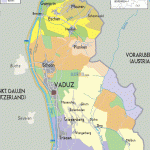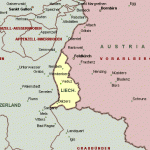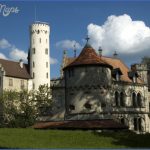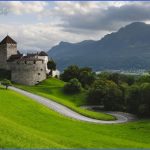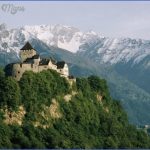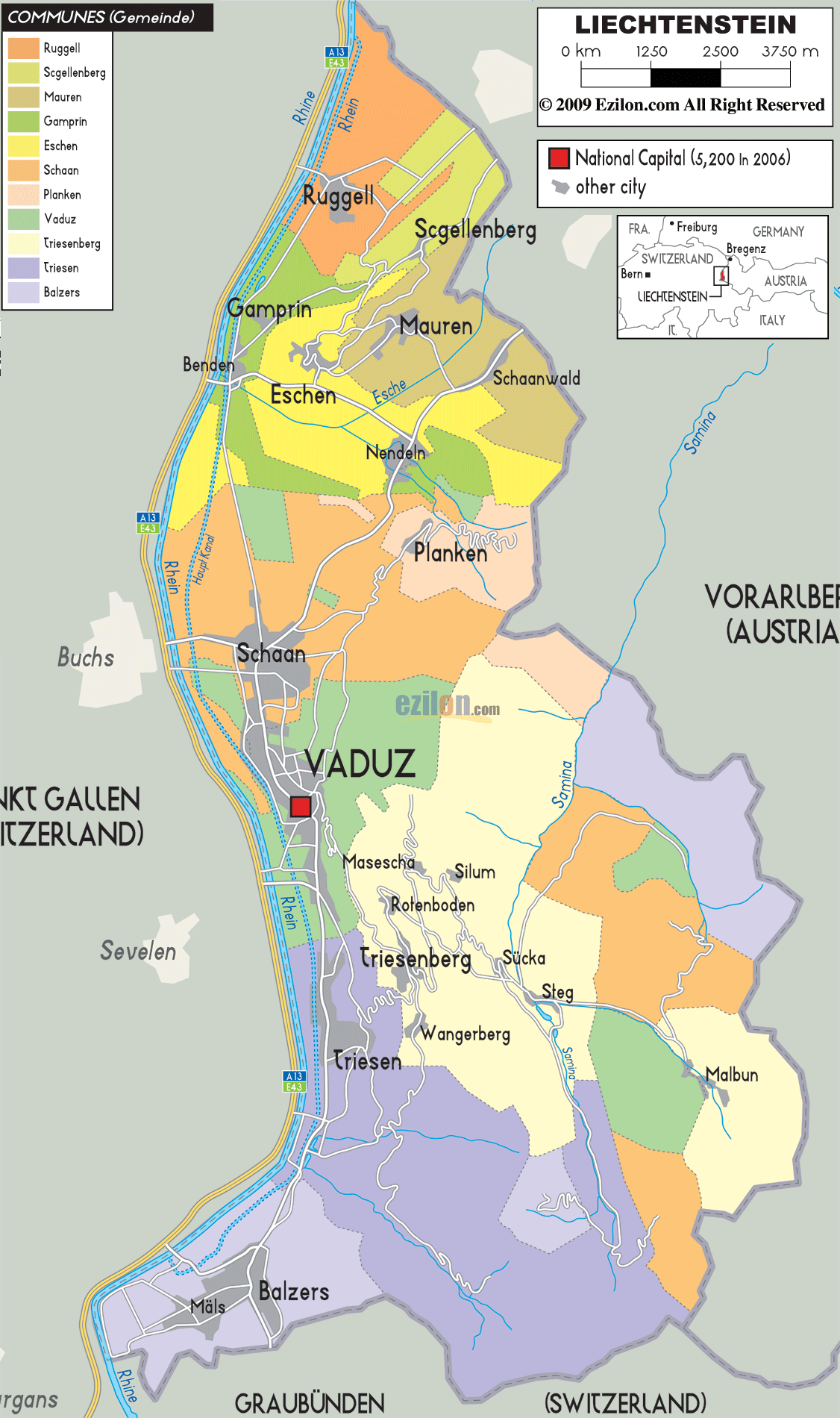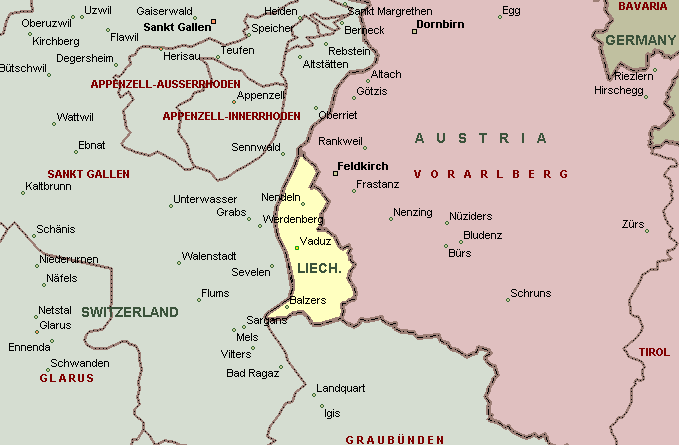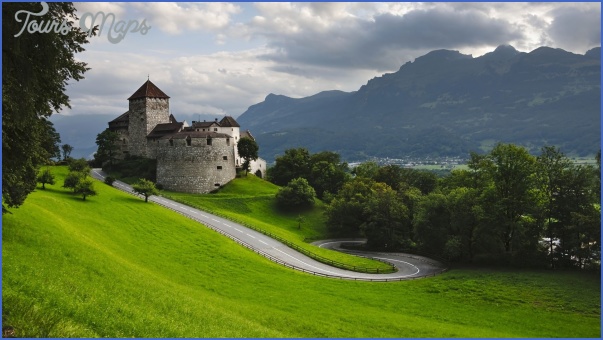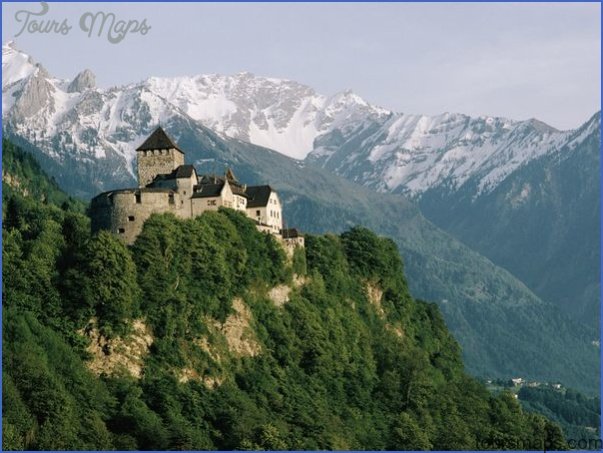Liechtenstein
Liechtenstein’s miniscule size and minute population (33,000) belies its long and rich history. The Romans invaded in 15 BC, but with the coming of Christianity in the 4th century AD, Germanic tribes pushed the Romans out, bringing the area under the control of the German dukedom. Prince Johann Adam of Liechtenstein purchased the land and created the Principality of Liechtenstein in 1719, which Napoleon conquered in 1806. After the defeat, Liechtenstein became part of the German Confederacy in 1815 and was granted a constitution in 1862. It separated from Germany for good in 1866 when the German Confederation dissolved. Two years later Liechtenstein disbanded its army an intimidating 80-man juggernaut which it has not re-formed since. In 1938, Prince Franz Josef ascended the throne and continued the transformation of Liechtenstein from an impoverished nation into one of the wealthiest (per capita) in Europe. Following the example of the Swiss, Liechtenstein established itself as an extremely desirable tax haven for international companies with its strict banking secrecy policies. The country joined the United Nations in 1990 and the European Economic Area in 1995.
DOCUMENTS AND FORMALITIES. Citizens of Australia, Canada, the EU, New Zealand, South Africa, and the US do not need a visa for stays up to 90 days.
TRANSPORTATION. To enter Liechtenstein, catch a bus from Sargans or Buchs in Switzerland, or from Feldkirch just across the Austrian border (20min. 4SFr). Although trains from Austria and Switzerland pass through the country, Liechtenstein itself has no rail system. Instead, it has a cheap, efficient Post Bus system that links all 11 villages (short trips 3SFr; long trips 4SFr, students half-price; SwissPass valid). A one-week bus ticket (lOSFr, students and seniors 5SFr) covers all of Liechtenstein as well as buses to Swiss and Austrian border towns. Bicycles are a great way to get around Lower Liechtenstein.
EMERGENCY. Police: 117. Ambulance: 144. Fire:118.
VADUZ AND LOWER LIECHTENSTEIN. As the national capital, Vaduz (pop.5,000) attracts the most visitors of any village in Lichtenstein. Above town, the 12th-century SchloS Vaduz (Vaduz Castle) is home to Hans Adam II, Prince of Liechtenstein. The interior is off-limits to the masses; however, you can hike up to the castle for a closer look and a phenomenal view of the whole country. The 15min. trail begins down the street from the tourist office, heading away from the post office. Across the street from the tourist office is the Kunstmuseum Liechtenstein, Stadtle 32. Mainly focusing on modem art, the museum boasts paintings by Dali, Kandinsky, and Klee, as well as rotating special exhibits and installations. (Open Su, Tu-W and F-Sa 10am-5pm, Th 10am-8pm. 8SFr, students and seniors 5SFr.) Liechtenstein’s national tourist office, Stadtle 37, one block up the hill from the Vaduz Post Bus stop, stamps passports (2SFr), sells hiking maps (8-16SFr), and gives hiking advice, (s-232 14 43. Open July-Sept. M-F 8am-5:30pm, Sa-Su 9am-5pm; Oct.-June M-F 8am-noon and l:30-5:30pm.) Budget lodgings in Vaduz are few and far between, but nearby Schaan is more inviting. Liechtenstein’s sole Jugendherberge , Untere Riittig. 6, is in Schaan. From Vaduz, take bus #1 to Miihleholz, walk toward the intersection with traffic lights, and turn left down Marianumstr. Walk 5min. and follow the signs to this spotless pink hostel on the edge of a farm. (232 50 22. Breakfast included. Reception daily 5-10pm. Checkout 10am. Open Feb.-Oct. Dorms 30SFr; doubles 40SFr.) Your best bet for a cheap meal is Migros supermarket, Aulestr. 20, across from the tour bus parking lot in Vaduz. (Open M-F 8am-lpm and 1:30-7pm, Sa 8am-6pm.)
UPPER LIECHTENSTEIN. Just when it seems that the roads cannot possibly become any narrower or steeper, they do welcome to Upper Liechtenstein. These heights are where the real character and beauty of Liechtenstein lie. Even if you’re in the country for one day, take the short bus trip to Triesenberg or Malbun (30min. from Vaduz) for spectacular views of the Rhine Valley below. Triesenberg (take bus #10), the principal town, is spanned by a series of switchbacks and foothills 800m above the Rhine. The tourist office (262 19 26) shares a building with the Walser Heimatmuseum, which chronicles the history of the region. (Both open June-Aug. Su
2-5pm, Tu-F l:30-5:30pm, Sa l:30-5pm; Sept.-May Tu-F l:30-5:30pm, Sa l:30-5pm. Museum 2SFr.) For great hiking, take bus #34 to Gaflei (20min. eveiy hr). Malbun sits in an alpine valley in the southeastern comer of Liechtenstein. It is undoubtedly the hippest place in the principality, home to approachable people, plenty of hiking, and affordable ski slopes (day-pass 33SFr). Contact the tourist office for more info. ( 263 65 77. Open June-Oct and mid-Dec. to mid-Apr. M-Sa 9am-noon and l:30-5pm.) The best place to stay for hiking and skiing access is Hotel Alpen , which is close to the bus stop and tourist office. (2631181. Reception daily 8am-10pm. Open mid-May to Oct. and mid-Dec. to Apr. In summer 45-65SFr per person; in winter add lOSFr.)
Liechtenstein Photo Gallery
Maybe You Like Them Too
- Explore Pulau Sebang Malaysia with this Detailed Map
- Explore Southgate, Michigan with this detailed map
- Explore Les Accates, France with this Detailed Map
- Explore Góra Kalwaria, Poland with this detailed map
- Explore Gumdag, Turkmenistan with this detailed map

